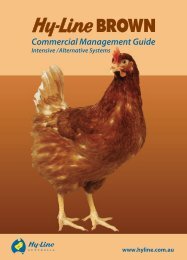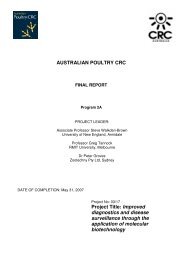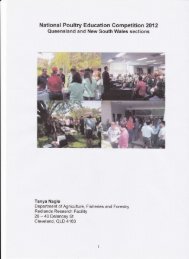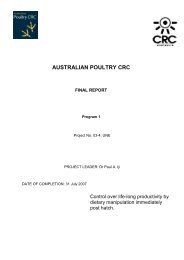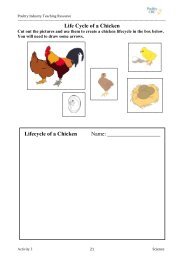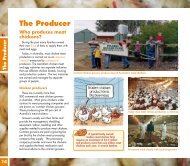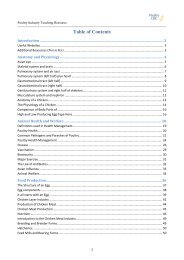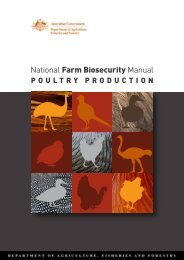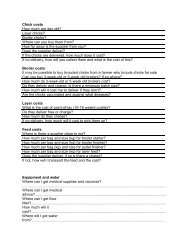AUSTRALIAN POULTRY CRC - Poultry Hub
AUSTRALIAN POULTRY CRC - Poultry Hub
AUSTRALIAN POULTRY CRC - Poultry Hub
- No tags were found...
You also want an ePaper? Increase the reach of your titles
YUMPU automatically turns print PDFs into web optimized ePapers that Google loves.
Plain English Compendium SummaryProject Title:Pilot trial – Mortality in free range flocks<strong>Poultry</strong> <strong>CRC</strong> Project No.: 05.13Researcher:Tanya NagleOrganisation:Department of Primary Industries & Fisheries<strong>Poultry</strong> Research & Development CentreALEXANDRA HILLS QLD 4161Phone: 07 3820 0504Fax: 07 3824 4316Email:Tanya.Nagle@dpi.qld.gov.auObjectivesUndertake a pilot study to develop a framework for a national survey oncauses of mortality in commercial free-range flocks.BackgroundFree range is the poultry housing system most actively supported by welfaregroups. Currently there are 1.69 million free range hens in Australia (11% oftotal laying hens in Australia) with an estimated grocery market share of14.5%. Free range eggs are worth 23% of the value of the Australian eggindustry, which is more than $71 million a year. Mortality in free range flockscan be caused by numerous factors including feather pecking and/orcannibalism, disease, predators and management (diet, housing, strain, rearing,light levels, vaccinations, flock size and density). There is limitedscientifically sound information on causes of mortality in free range flocks inAustralia and we will start to address this.ResearchA survey of all free-range producers in Australia was undertaken to indicatecauses of mortality in the industry to tailor future epidemiological surveys toensure temporal/locality issues were covered. A small focusedepidemiological study on the causes of mortality in five commercial free rangeflocks in Southeast Queensland including a detailed survey of participatingfarms, ongoing mortality records, serology, faecal samples and grosspathology was completed.Outcomes Fourteen free range producers replied to the nationwide survey (QLD – 5,NSW – 1, VIC – 4, SA – 4) with fowl cholera named as the most importantcause of mortality in Queensland and spotty liver the most important cause ofmortality in New South Wales and Victoria. Queensland and Victoria hadproblems with predators with Victoria also recording heat stress as animportant cause of mortality. Egg peritonitis, prolapse/protusion, cannibalismand vent pecking were all seen as important causes of mortality in all states.Of the five flocks that were studied in the intensive epidemiological survey inSoutheast Queensland one farm had a small increase in the average egg dropsyndrome vaccine titre with this farm and two others showing a decrease in thenumber of positive samples over the period of the survey. One farm initiallyshowed a negative average infectious bronchitis vaccine titre however this hadincreased to become positive in the final sample. Overall, all flocks had apositive average Newcastle vaccine titre throughout the survey; however twofarms had only 54% and 64% of samples returning positive titres. Fowltyphoid was the most common cause of mortality with cannibalism the secondmost common cause.ImplicationsBacterial infections effect birds on the ground more than birds in cages whichimpacts on their welfare and adds to the production costs in alternativesystems. Significant economic losses to producers occur because eggproduction drops and mortality increases. Food safety could also becompromised. Recommendations include typing of salmonella present incurrent trial allowing specific prevention and control information to beprovided to producers, approval of more antibiotics and anthelmintics for usein laying hens, an investigation into the microbial population of the oviduct infree range, barn and cage laying hens with the possibility of developingprobiotics, and increased producer education and improved use andavailability of professionals to ensure early and correct diagnosis of causes ofmortality.



